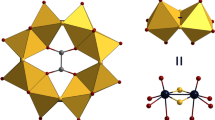Abstract
Dinuclear complexes containing a (μ-oxo)bis(μ-carboxylato) diruthenium (III) core have been prepared by a novel synthetic route using metal-metal bonded diruthenium(II, III) tetracarboxylates as precursors. The complexes have been structurally characterized and they are redox active. The terminal ligands play an important role in tuning the electronic structure of the core. The stability of the core is found to be dependent on the size and π-acidic nature of the terminal ligandcis- to the μ-oxo ligand. The chemistry of such tribridged complexes is relatively new. The rapid growth of this chemistry is based on the discovery of similar core structures in several non-heme iron-and manganese-containing metalloproteins. The tribridged core presents a new structural motif in coordination chemistry. The chemistry of diruthenium complexes with a [Ru2(μ-O)(μ-O2CR) 2+2 ] core has been reviewed.
Similar content being viewed by others
References
Barral M C, Jimenez-Aparicio R, Kramalowsky R and Wagner I 1993Polyhedron 12 903
Cannon R D and White R P 1988Prog. Inorg. Chem. 36 195
Cotton F A and Walton R A 1993Multiple bonds between metal atoms (Oxford: University Press)
Das B K and Chakravarty A R 1990Inorg. Chem. 29 2078
Gupta N, Mukherjee S, Mahapatra S, Ray M and Mukherjee R 1992Inorg. Chem. 31 139
Kurtz D M Jr 1990Chem. Rev. 90 585
Llobet A, Curry M E, Evans H T and Meyer T J 1989Inorg. Chem. 28 3131
Que L Jr and True A E 1990Prog. Inorg. Chem. 38 97
Sasaki Y, Suzuki M, Nagasawa A, Tokiwa A, Ebihara M, Yamaguchi T, Kabuto C, Ochi T and Ito T 1991Inorg. Chem. 30 4903
Stenkamp R E, Sieker L C and Jensen L H 1984J. Am. Chem. Soc. 106 618
Sudha C, Mandal S K and Chakravarty A R 1993Inorg. Chem. 32 3801
Syamala A 1994Aspects of the chemistry of (μ-oxo) bis (μ-carboxylato) diruthenium complexes, Ph D thesis, Department of Inorganic & Physical Chemistry, Indian Institute of Science, Bangalore
Syamala A and Chakravarty A R 1991Inorg. Chem. 30 4699
Syamala A and Chakravarty A R 1993Polyhedron 12 1545
Syamala A and Chakravarty A R 1995Polyhedron 14 231
Syamala A, Nethaji M and Chakravarty A R 1995Inorg. Chim. Acta 219 33
Wieghardt K 1989Angew. Chem., Int. Ed. Eng. 28 1153
Wieghardt K 1994Angew. Chem. 106 765
Wieghardt K, Bossek U, Neves A, Nuber B and Weiss J 1989Inorg. Chem. 28 432
Author information
Authors and Affiliations
Rights and permissions
About this article
Cite this article
Chakravarty, A.R. Tribridged diruthenium complexes: A new structural motif. Proc. Indian Acad. Sci. (Chem. Sci.) 108, 207–216 (1996). https://doi.org/10.1007/BF02870026
Issue Date:
DOI: https://doi.org/10.1007/BF02870026




